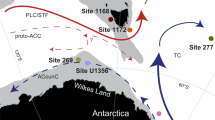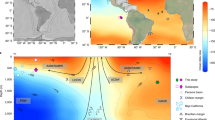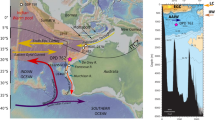Abstract
Ocean circulation and climate are strongly interconnected. Under climatic conditions very different from those of today, deep and intermediate water circulation was subject to drastic changes1–7. For instance, during the last glacial maximum (LGM), deep ocean water was cooler than now by several degrees8. These temperature changes in the deep ticean were associated with striking variations in chemical characteristics of the intermediate and deep water masses of the Atlantic and Pacific Oceans3,8–13. Here we reconstruct the hydrological structure of the deep and intermediate water of the Indian Ocean during LGM (∼18,000yr BP). The carbon and oxygen isotope analyses of the benthic foramiriifira genus Cibicides show that the water-column structure of the Indian Ocean during; LGM was marked by the presence of a deep front separating intermediate and deep-water masses with very different characteristics: Intermediate-water mass temperatures and §13C were similar to those of today. By contrast, the Jeep water was cooler than iiow by at least 1.5 °C, more depleted in 13C and poorly oxygenated.
This is a preview of subscription content, access via your institution
Access options
Subscribe to this journal
Receive 51 print issues and online access
$199.00 per year
only $3.90 per issue
Buy this article
- Purchase on Springer Link
- Instant access to full article PDF
Prices may be subject to local taxes which are calculated during checkout
Similar content being viewed by others
References
Duplessy, J. C., Moyes, J. & Pujol, C. Nature 286, 479–482 (1980).
Duplessy, J. C. et al. Quat. Res. 21, 225–243 (1984).
Duplessy, J. C. et al. Paleoceanography (in the press).
Shackleton, N. J., Imbrie, J. & Hall, M. A. Earth planet. Sci. Lett., 65, 223–244 (1983).
Duplessy, J. C. & Shackleton, N. J. Nature 316, 500–507 (1985).
Boyle, E. A. & Keigwin, L. D. Science 218, 784–787 (1982).
Boyle, E. A. & Keigwin, L. D. Earth Planet. Sci. Lett. 76, 135–150 (1986).
Labeyrie, L. D., Duplessy, J. C. & Blanc, P. L. Nature 327, 477–482 (1987).
Labeyrie, L. D. & Duplessy, J. C. Paleogeogr. Paleoclimatol. Paleoecol. 50, 217–240 (1985).
Oppo, D. & Fairbanks, R. G. Earth planet. Sci. Lett. 86, 1–15 (1987).
Curry, W. B. & Lohmann, G. P. Quat. Res. 18, 218–235 (1982).
Curry, W. B., Duplessy, J. C., Labeyrie, L. D. & Shackleton, N. J. Paleoceanography (in the press).
Boyle, E. A. & Keigwin, L. D. Nature 330, 35–40 (1987).
Wyrtki, K. in The biology of the Indian Ocean (ed. Zeitzschel, B.) 18–36 (Springer, Berlin, 1973).
Gordon, A. L. J. geophys. Res. 91, 5037–5046 (1986).
Mantyla, A. W. & Reid, J. L. Deep Sea Res. 30, 805–833 (1983).
Broecker, W. S., Takahashi, Ta, & Takahashi, Ti, J. geophys. Res. 90, 6925–6939 (1985).
Kroopnick, P. Deep Sea Res. 32, 57–84 (1985).
Zahn, R., Winn, K. & Sarnthein, M. Paleoceanography 1, 27–42 (1986).
Emiliani, C. J. Geol. 63, 538–578 (1955).
Shackleton, N. J. in Variation du Chimat au Cours du Pleistocène (ed. Labeyrie, J.) 203–209 (CNRS Paris, 1974).
Shackleton, N. J. & Opdyke, N. D. Quat. Res. 3, 39–55 (1973).
Duplessy, J. C. in Climatic Change (ed. Gribbin., J. 46–67 (Cambridge University Press, 1978).
Shackleton, N. J. in The Fate of Fossil Fuel CO2 in the Oceans (ed. Anderson, N. R. & Malahoff, A. 401–427 (Plenum, New York, 1977).
Broecker, W. S. Prog. Oceanogr. 11, 151–197 (1982).
Streeter, S. S. & Shackleton, N. J. Science 203, 168–171 (1979).
Warren, B. A. Deep Sea Res. 28A, 759–788 (1981).
Fieux, M., Schott, F. & Swallow, J. C. Deep Sea Res. 33, 415–426 (1986).
Birchfield, G. E. Paleoceanography 2, 431–442 (1987).
GEOSECS Indian Ocean Expedition Vol. 5 (eds Weiss, R. F., Broecker, W. S., Craig, H. & Spencer, D.) (IDOE NSF, Washington, DC, 1983).
Shackleton, N. J. Quat. Sci. Rev. 6, 183–190 (1987).
Duplessy, J. C. Nature 295, 494–498 (1982).
CLIMAP Project Members Science 191, 1131–1137 (1976).
Boyle, E. A. Nature 331, 55–56 (1988).
Sarnthein, M., Winn, K., Duplessy, J. C. & Fontugne, M. Paleoceanography (submitted).
Author information
Authors and Affiliations
Rights and permissions
About this article
Cite this article
Kallel, N., Labeyrie, L., Juillet-Leclerc, A. et al. A deep hydrological front between intermediate and deep-wafpr , masses in the glacial Indian Ocean. Nature 333, 651–655 (1988). https://doi.org/10.1038/333651a0
Received:
Accepted:
Issue Date:
DOI: https://doi.org/10.1038/333651a0
This article is cited by
-
Southern Ocean glacial conditions and their influence on deglacial events
Nature Reviews Earth & Environment (2023)
-
Glacial–interglacial contrast in deep-water δ13C of the Arabian Sea
Journal of Earth System Science (2022)
-
Glacial-interglacial changes in the surface water characteristics of the Andaman Sea: Evidence from stable isotopic ratios of planktonic foraminifera
Journal of Earth System Science (2000)
-
Palaeomonsoon and palaeoproductivity records of δ18O, δ{13}C and CaCO3 variations in the northern Indian Ocean sedimentsC and CaCO3 variations in the northern Indian Ocean sediments
Journal of Earth System Science (2000)
-
Stable isotopic records of the glacial deep-water properties in the South China Sea
Science in China Series D: Earth Sciences (1998)
Comments
By submitting a comment you agree to abide by our Terms and Community Guidelines. If you find something abusive or that does not comply with our terms or guidelines please flag it as inappropriate.



